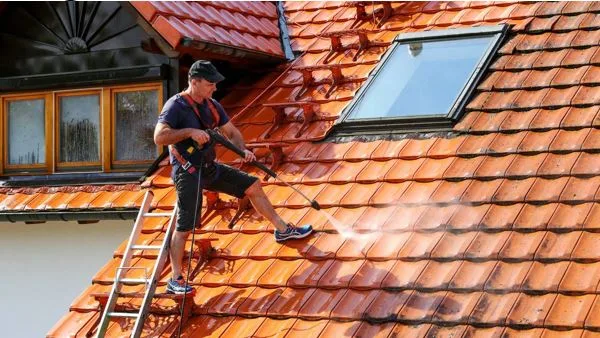The Ultimate Guide To Roof Cleaning In The Uk: Detailed Insights And Best Practices
A well-maintained roof is critical for any UK home, not only to protect against harsh weather but also to preserve structural integrity and enhance property value. Due to the UK’s unique climate—characterised by frequent rainfall, dampness, and shade—roof cleaning is an essential yet often overlooked aspect of home maintenance. This guide delves deep into why Edinburgh roof cleaning matters, common challenges faced by UK roofs, effective cleaning techniques, and post-cleaning maintenance tips to keep your roof in optimal condition.
Why Edinburgh Roof Cleaning is Essential
The British climate provides ideal conditions for the rapid growth of moss, algae, lichen, and fungi on roofing materials. These biological contaminants retain moisture, which can seep into roofing tiles and underlay, accelerating decay and leading to leaks or even structural damage. Unlike dry, sunny climates where such growth is minimal, the UK’s humid environment means that many roofs require cleaning regularly to prevent damage.
Moss is particularly problematic because it acts like a sponge, holding water against tiles, which can freeze and thaw during colder months, causing cracking and displacement. Over time, this compromises the waterproofing of your roof, leading to damp issues inside the property.
Additionally, accumulated debris such as leaves and twigs block gutters and downpipes, causing water overflow that damages fascia boards and walls. Hence, roof cleaning is not merely cosmetic—it is vital for preventing expensive repairs and preserving your home’s longevity.
Common Problems Affecting UK Roofs
Moss and Algae Growth
Moss thrives in shaded, moist areas. Roof sections shaded by trees or on the north side of buildings often suffer the worst growth. Algae tend to appear as black streaks or discolorations and are more common in urban areas with pollution.
Both moss and algae degrade the roofing material over time by holding moisture and sometimes secreting acidic substances that break down tiles or slates.
Lichen and Fungi
Lichen grows slowly but is a tough organism that can adhere tightly to roofing surfaces, leading to micro-cracks and deterioration. Certain fungi may invade wooden elements of the roof, causing rot and weakening the structure.
Environmental and Pollution Effects
Urban pollution contributes grime and soot, which settles on roofs, accelerating material breakdown and staining surfaces. Coastal homes face salt spray, which further corrodes roofing metals and tiles.
Detailed Roof Cleaning Methods
Soft Washing
Soft washing is widely regarded as the safest and most effective cleaning method for UK roofs. This process involves applying a specially formulated biodegradable solution that kills moss, algae, and lichen at the roots, followed by a gentle rinse with low-pressure water.
Soft washing prevents the physical damage often caused by scrubbing or pressure washing and leaves the roof clean without disturbing the tiles or coatings. It also helps reduce the speed of regrowth, especially when paired with follow-up treatments.
Manual Cleaning
For heavy moss infestations, manual removal may be necessary. Using soft-bristle brushes or plastic scrapers, professionals carefully remove moss layers without dislodging or damaging tiles. This method requires experience, as aggressive scrubbing can break fragile tiles, especially on older roofs.
Pressure Washing
Although pressure washing is effective in quickly removing dirt and moss, it is generally not recommended for most UK roofs. The high water pressure can force water beneath tiles, causing leaks, and damage delicate roofing materials.
Pressure washing should only be used on very sturdy roof types, such as concrete tiles, and always by trained professionals who understand how to control the pressure and angle.
Chemical Treatments and Preventative Solutions
After cleaning, applying chemical treatments is essential to inhibit regrowth of moss and algae. These treatments usually involve zinc or copper-based compounds, which are effective but must be used carefully to avoid harming nearby plants or watercourses.
Many professional roof cleaners also offer maintenance packages that include periodic chemical reapplications to keep roofs protected throughout the year.
When is the Best Time to Clean Your Roof?
Timing is critical in the UK, where weather can be unpredictable. The ideal time for roof cleaning is during dry spells in spring or early autumn. These seasons provide mild temperatures and less rainfall, which ensure cleaning solutions work effectively and roofs dry properly.
Avoid cleaning roofs during winter when frost can damage wet tiles or in summer when intense sun can cause cleaning chemicals to evaporate too quickly.
Safety Concerns and Professional Roof Cleaning
Cleaning roofs involves working at height, often on steep and slippery surfaces. Safety risks include falls and injuries from unstable ladders or fragile tiles. Professional roof cleaners have the training, equipment, and insurance needed to conduct the work safely.
Professionals also carry out thorough roof inspections before cleaning, identifying damaged tiles, leaks, or other issues that may require repair, thus preventing future problems.
Benefits of Regular Roof Cleaning
Regular roof cleaning provides multiple benefits beyond aesthetics. It significantly extends the roof’s lifespan by reducing moss and algae-induced deterioration. Clean roofs improve water drainage and prevent blockages in gutters, reducing the risk of water ingress.
Moreover, a clean roof enhances your property’s curb appeal and can increase its market value. Clean, well-maintained homes attract more buyers and often sell faster.
Post-Cleaning Maintenance Tips
Maintaining your roof after cleaning is crucial for long-term protection. Here are some tips:
- Gutter Maintenance: Regularly clear gutters and downpipes to prevent water backup.
- Tree Pruning: Trim back branches that overhang the roof to reduce shade and leaf accumulation.
- Regular Inspections: Schedule roof checks every 6–12 months to spot moss regrowth or damage early.
- Install Moss-Resistant Materials: When re-roofing, consider tiles or slates treated with anti-moss coatings.
Conclusion
Roof cleaning in the UK is a vital maintenance task shaped by the country’s wet climate and environmental challenges. Effective cleaning methods such as soft washing combined with professional expertise help preserve roofing materials, prevent damage, and maintain property value. By scheduling regular cleanings and following up with proper maintenance, homeowners can protect their roofs against the damaging effects of moss, algae, and pollution for many years to come.
For more insights into property care and maintenance, including expert advice on increasing home value, visit Techbish Real Estate. Staying informed helps you make smarter decisions about protecting your property investment.






